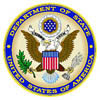| United States Embassy Tokyo, Japan |
 |
||
| Welcome to the U.S. Embassy in Tokyo. This site contains information on U.S. policy, public affairs, visas and consular services. |
|
|
||||||||||||||||||||||||||||||
|
(The following byliner is in the public domain. No republication restrictions.)
Afghanistan: Not Always a Battlefield
By Paula J. Dobriansky
(The author is U.S. Under Secretary of State for Global Affairs.)
The current generation of young Afghans cannot remember a time when their country really worked. There was a time - a little over 20 years ago - when Afghanistan was a functioning state, a member of the world community. Afghanistan, while always poor and rugged, was home to a proud people who had aspirations and hopes for a better future. Afghans ran their own country, children went to school, people had enough to eat, and women were educated and employed.
Unfortunately it is now difficult to remember that functioning Afghanistan. The time before the Taliban - before the civil war, before the Soviet invasion - seems like another age. Yet, Afghans can and should find their way back to a normal society and functioning country.
Life in Afghanistan, even before the conflict, was not easy. It was among the ten or so poorest countries in the world. Natural resources were limited and subsistence farming constituted the main activity of the majority of Afghans. Infrastructure was under-developed. Improvement in the lives of most Afghans depended to a large extent on the activities of foreign relief and development agencies.
But Afghan society worked. Despite hardships, Afghans ran their country and raised their families. An educational system operated in most cities and towns, educating both boys and girls. Afghan universities produced a cadre of educated elites who provided the manpower for the government and for the private sector economy. Health care in hospitals was available in the cities, while in rural areas, more rudimentary healthcare was provided by government-trained nurses. Subsistence farming, coupled with foreign assistance - including from the U.S. Agency for International Development (USAID) - provided sufficient sustenance so that for the majority of Afghans the threat of famine was virtually non-existent.
Before chaos and destruction descended on Afghanistan, Afghan women had the freedom to take part in the life of their country. Educated urban women held positions in medicine, business, education, and the media. There were women working in nearly all government ministries. There were women judges and lawyers. A few women held elective political office. Prior to the Taliban takeover of Afghanistan women made up more than half of all students at Kabul University, 70 percent of the nation's schoolteachers, half of all civilian government workers, and 40 percent of the doctors in Kabul.
Political power in Afghanistan was exercised both by a national government and by traditional means: the central leadership in Kabul controlled national functions such as foreign policy and defense, provided resources for education, health care, and transportation. Provincial governors were appointed by the central government. In the countryside, where most Afghans lived, village and tribal elders ruled on issues of local concern; if an issue had wider impact, a group of such elders from a number of neighboring villages would gather to debate the problem and reach a resolution. The power of these elders stemmed not from the barrel of a gun, but from the prestige and lineage of the individual, and from his character and achievements. This informal, yet centuries-old means of wielding political power was accepted by the people, and recognized by the government.
Afghanistan once played a proper role on the world stage. Relations with neighboring states were normal. The United States maintained a large aid program focused on agricultural development and health care. One of USAID's flagship efforts, the Helmand River irrigation project, brought irrigation to farms in southern Afghanistan.
Afghanistan can once again be a country that works, a functioning member of the world community. To put Afghanistan back together again, Afghans will have to regain control of their country's future. They will have to work together, with all Afghans who love their country, to build a future for themselves and their children. The world community will help, as it has helped with humanitarian aid over the last two decades. The Afghanistan of 25 years ago, now a distant memory, is a reminder of what is possible in the future. Afghans deserve a chance to reclaim and rebuild their nation. It is this Administration's key goal to help in this endeavor.
(end byliner)
# # #
![]()